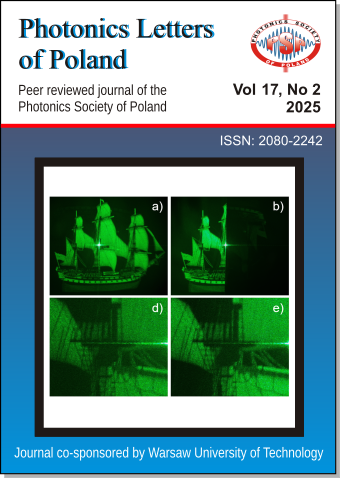Journal Indicators:
CiteScore 2024 1.0
IF 0.8
H-index 19
SJR 0.265
Points on list of rated journals of the Ministry of Education and Science 40 (punkty z oficjalnej listy Ministerstwa Edukacji i Nauki )
PSP Photonics Letters of Poland (ISSN 2080-2242) is a new peer-reviewed web-based, open-access journal published by the Photonics Society of Poland and co-sponsored by SPIE. Journal is also supported by the Ministry of Science and Higher Education of Poland in the frame of the project 699/P-DUN/2017.
CiteScore 2024 1.0
IF 0.8
H-index 19
SJR 0.265
Points on list of rated journals of the Ministry of Education and Science 40 (punkty z oficjalnej listy Ministerstwa Edukacji i Nauki )

This issue of Photonics Letters of Poland presents a diverse collection of photonics research, spanning holography, spectroscopy, fiber-optic sensing, and environmental monitoring. Each contribution presents innovative approaches to solving real-world challenges using advanced photonic technologies. Specifically: (i) A comparative study of phase-only hologram encoding methods reveals that Direct Phase-only Holograms (D-PoH) offer the best performance for wide-angle displays. The paper also proposes improvements to the Complex Amplitude Modulation (CAM) method to address its limitations in brightness and image quality. (ii) Raman spectroscopy, supported by SEM imaging, is used to analyze and identify the composition and morphology of unknown human kidney stones. This non-invasive technique demonstrates strong potential for clinical diagnostics and personalized treatment planning. (iii) Investigations on microplastic emissions from nail styling materials, identifying particles with allergenic and potentially harmful properties, is presented. The findings underscore the need for exposure assessments and emission control strategies in enclosed environments like beauty salons. (iv) A PVDF-coated Fabry–Pérot fiber-optic sensor is introduced for detecting PFAS in water, showing reversible spectral shifts and high repeatability. Its low cost and portability make it ideal for in situ environmental monitoring. (v) The spatial modulation of the pump beam enabling lasing in cholesteric liquid crystal layers is also presented. It also shows the feasibility of dynamic optical data recording on thin laser-active layers. (vi) A hollow-core photonic crystal fiber sensor combined with deep learning achieving 96.3% accuracy in detecting lung cancer from exhaled breath is shown. This approach offers a promising path toward portable, non-invasive early diagnostic tools. (vii) A V-grooved, gold-coated photonic crystal fiber sensor operating in the NIR range exhibiting exceptional sensitivity and resolution for tumor detection is studied. Its optimized design ensures minimal loss and high efficiency in distinguishing healthy from cancerous tissues. (viii) Theoretical modeling of a graphene light source integrated with a silicon membrane reveals its potential as a miniaturized, tunable IR emitter. The study explores spectral tuning capabilities based on membrane deflection and device geometry.
The Photonics Letters of Poland is indexed in major scientific databases, including Scopus and Web of Science Emerging Sources Citation Index.
The journal covers the topical areas of optics, optoelectronics and photonics in the following aspects: fundamental and applied research, physics and technical, materials, components and devices, circuits and systems, technological and design, construction and manufacturing, and metrology.
Photonics Society of Poland encourages the prospective Authors to publish the results of their research and technical work in the new, peer-reviewed, rapid Internet journal Photonics Letters of Poland.
The Advisory Board of the Photonics Letters of Poland is composed of Polish researchers active in optics and photonics, whereas the International Advisory Board groups prominent international experts and scientists in the field.
Members of the International Advisory Board:
Journal Indicators:
CiteScore 2024 1.0
IF 0.8
H-index 19
SJR 0.265
Points on list of rated journals of the Ministry of Education and Science 40 (punkty z oficjalnej listy Ministerstwa Edukacji i Nauki )
